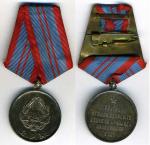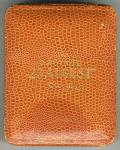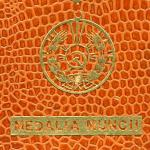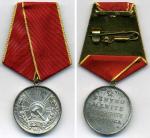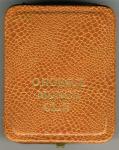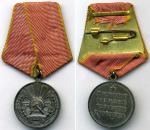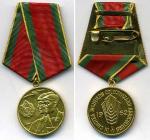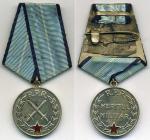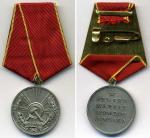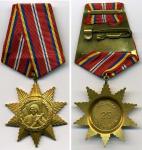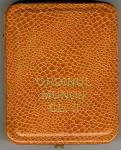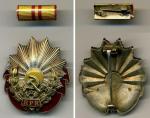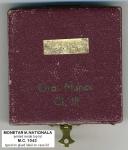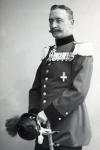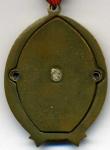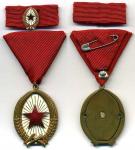-
Posts
10,252 -
Joined
-
Last visited
-
Days Won
38
Content Type
Profiles
Forums
Blogs
Gallery
Events
Store
Everything posted by Stogieman
-

Romania A Small Collection of Romanian Items
Stogieman replied to Stogieman's topic in Central & Eastern European States
-

Romania A Small Collection of Romanian Items
Stogieman replied to Stogieman's topic in Central & Eastern European States
-

Romania A Small Collection of Romanian Items
Stogieman replied to Stogieman's topic in Central & Eastern European States
-

Romania A Small Collection of Romanian Items
Stogieman replied to Stogieman's topic in Central & Eastern European States
This is my only RSR era piece... a Labor Medal, with document. It's in a RPR case that someone very carefully scratched out the "P" in RPR! -

Romania A Small Collection of Romanian Items
Stogieman replied to Stogieman's topic in Central & Eastern European States
Here's another early example of the RPR Order of Labor, Second Class. This time no number on pin or back of order. -

Romania A Small Collection of Romanian Items
Stogieman replied to Stogieman's topic in Central & Eastern European States
-

Romania A Small Collection of Romanian Items
Stogieman replied to Stogieman's topic in Central & Eastern European States
-

Romania A Small Collection of Romanian Items
Stogieman replied to Stogieman's topic in Central & Eastern European States
-

Romania A Small Collection of Romanian Items
Stogieman replied to Stogieman's topic in Central & Eastern European States
-

Romania A Small Collection of Romanian Items
Stogieman replied to Stogieman's topic in Central & Eastern European States
-

Romania A Small Collection of Romanian Items
Stogieman replied to Stogieman's topic in Central & Eastern European States
http://gmic.co.uk/uploads/monthly_09_2011/post-120-0-49170100-1317391915.jpghere's a close-up of the number stamped in the pin: -

Romania A Small Collection of Romanian Items
Stogieman replied to Stogieman's topic in Central & Eastern European States
-

Romania A Small Collection of Romanian Items
Stogieman replied to Stogieman's topic in Central & Eastern European States
Now, to further complicate the questions.... Here's another example (2.Kl.) with a numbered pin, as opposed to a number stamped into the backing plate. Later case, possibly/probably mis-matched? -

Romania A Small Collection of Romanian Items
Stogieman replied to Stogieman's topic in Central & Eastern European States
-

Romania A Small Collection of Romanian Items
Stogieman replied to Stogieman's topic in Central & Eastern European States
I received this interesting Order of Labor (RPR, 3.Kl.) not too long ago. It raises a lot of questions for me.... Looks like a "Royalty" era case? The paper tag on the lid that matches the stamping? Why the numbering? I've seen an awful lot of this award floating about.... but precious few numbered? How rare is this style/type? Here's some details from Rick Research's scanner: -
My problems with this bar are a little more basic. However I agree with all of the "deeper" responses. I look at this bar and at a simple first glance find it impossible to accept as authentic for two reasons: A) I have never seen a professionally made German medal bar of this caliber that did not have precisely identical and perfect ribbon mounts. B) The bright color/brand new look of the ribbons alone on a bar of this era make me cringe.
-

Hungary My New Hungarian Medals & Badges
Stogieman replied to Stogieman's topic in Central & Eastern European States
-

Hungary My New Hungarian Medals & Badges
Stogieman replied to Stogieman's topic in Central & Eastern European States
-

Romania A Small Collection of Romanian Items
Stogieman replied to Stogieman's topic in Central & Eastern European States
More images. Maybe it's the resemblance to early imperial era breast stars? In any event, I am quite pleased with this example! -

Romania A Small Collection of Romanian Items
Stogieman replied to Stogieman's topic in Central & Eastern European States
I cannot explain the fascination I have with this order. It just seems very beautiful to me. I have recently acquired a Fourth Class Cased to go with the Fifth Class I already have watch over. -
Not that rare, I was able to buy several a few years back for substantially less than 2000- Euro. I will be outright stunned if this piece (which is still in production and available in Cuba) would sell for that price.....
-
The 4 ribbon bar is in Prussian precedence (1920s) with dulled but real silver X device and faded Bavarian long service award in last place, while the lower bar (these came together from the same source) dates from during the war while in Bavarian uniform. Divided by rank, these potential silver X rankers were Wachtmeister-Offizierstellvertreter = 1 (listed as a regular) Feldwebel = 4 (all listed as regulars, meaning all would have had a Jubilee Medal 1905 or 1911) Wachtmeister = 7 (6 regularsas aboveand 1 dL probably no Jubilee Medal) Vizefeldwebel-Offizierstellvertreter = 4 (3 listed as regularsas aboveand 1 dLas above) Vizewachtmeister-Offizierstellvertreter = 2 (1 a regular and 1 dR as noted above for Jubilee or not) Unterzahlmeister = 3 (1 perhaps a regular but 2 listed with civilian occupations so NOT regulars)j Vizefeldwebel = 21 (14 regulars, 3 dR, and 4 dL likely no Jubilees but regulars held long services) Vizewachtmeister = 8 (5 regulars, 2 dR and 1 dL as noted above) Offizierstellvertreter (without permanent NCO grade listed) = 4 Beamten-Stellvertreter = 1 (listed as a regular but this was a wartime temporary generic rank) Of those 55, 17 had their SMMs gazetted in the Bavarian wartime issues of the Personal Nachrichten. One of the VWms can be removed as a suspect since he was later a Lt dR with no long service award. None of the others had any other foreign awards gazetted in the PN, leaving only class of BMVK to reduce potential suspects. The senior 18 NCOs above would either have had a Luitpold Jubilee Medal and a long service award or a long service award, based on whether regulars or Reserve or Landwehrprobably 11 with a 1905 or 1911 Jubilee and long service, so that many can be deducted as suspects. 238 junior NCOs and men who would have received one of the bronze BMVK3X classes (of whom 99 were gazetted in the PN), by rank were as follows Sergeant = 21 Unteroffizier = 70 Oberjäger = 2 Obergefreiter = 2 Gefreiter = 58 Privates in all branches of the Bavarian army = 85 Please bear in mind that of these 55 senior NCOs and 238 junior NCOs and privates, virtually every one who received ANY class of a Bavarian Military Merit Cross would have had that gazetted in the Personal Nachrichten, so pursuing each one of the 293 individually would result in further distinctions possible in BMVKs by classes with Swords and with or without Crown. (It has over 30 years since Ive had access to the Personal Nachrichtenin the Library of the U.S. Congress, of all places!) Here is a gigantic home-made ribbon bar from the Weimar Republic era, for a non-career junior NCO or private: In Prussian precedence, this startling bars array of very ordinary common awards from states of the Empire with no apparent common service CAN be explained If the recipient was a member of K.B. Infanterie Regiment 8 ,,Großherzog Friedrich II. von Baden. 216 members of that regiment had Baden awards gazetted in the wartime PNs. 35 of 60 Zähringen Lion Orders were gazetted, for some idea of the likely proportion of awards NOT gazetted. After the war, its original wearer was back in Prussian territory, wearing his EK2 first. As a former-Bavarian, his BMVK3X came next (the gold swords must NEVER be taken to indicate a BMVK1X without proper contextflashier gold swords devices were routinely used for correct bronze ones. These are of an oddball type only used on 1920s vanity veterans private purchase awards). Next his hometown SMM, then the otherwise inexplicable Baden Silver Merit Medal on MKFVO ribbon, and finally (he was a true warrior) a 1919-21 Silesian Eagle 2nd Class. So WAS this possible? Indeed FIVE Meiningers (who received SMMs) strayed into the ranks of Bavarian Infantry Regiment 8 One was a Vizefeldwebel-Offizierstellvertreter who can be excluded as a silver X grade NCO. The other 4 were 1) Gefreiter Karl Böttner of 3rd Company, 2) Gefreiter Friedrich Dreßler of 6th Company (gazetted in PN), 3) Gefreiter Artur Jakob of 9th Company (gazetted in PN), and 4) Unteroffizier dR Christian Kallenbach of 9th Company It would be extraordinarily difficult to come up with any other suspects in the sort of miniscule specialist units (independent signals platoons, mountain mule sections etc) which had no Inhaber or territorial origin. But it is always possible that a random stray or several COULD be lost in such micrto-units and thus be invisible. It has always been a truism that the lower a soldiers rank, the less likely he was/is to be decoratedespecially lavishly. By contrast, a mere 5 SMM holders were Meininger strays in Baden units (all of them in Ers Inf Rgt 28), 1 was a Badener in Meiningens own Inf Rgt 32, and 2 SMM recipients from Baden were in Saxon units. So here we see common awards whose recipients can be, respectively, reduced to 1-of-54-or-less and probably-1-of-4… out of the entire Bavarian army! It all comes down to having COMPLETE Rolls transcribed. Source: Award Roll of the Saxe-Meiningen War Merit Medal, transcribed by me Potential sources for further research: The Bavarian wartime ,,Personal Nachrichten, and Ancestry-dot-coms Bavarian infantry records online.
-
Words from Rick Research: One of the most commonly misunderstood aspects of researching anonymous Imperial German award groups is how rare COMBINATIONS of otherwise common awards actually were. Case in point, the prolific Great War numbers of Bavarian Military Merit Crosses (BMVKs with Xs) and Saxe-Meiningen War Merit Medals (SMM). With literally hundreds of thousands of the former (in the BMVK3X bronze classes) and almost 23,000 of the latter, neither of these awards could be considered rare. Individually. But how many SMMs were bestowed on NCOs, NCO-equivalent military officials, and privates in the Bavarian army? A grand (drum roll please) total of 293. None of those SMMs to Meininger “strays” in Bavarian uniform (as all were) went to Warrant Officers (Feldwebelleutnant and equivalent) who would have received a BMVK1X. Possible recipients of a BMVK2X only numbered 55—and here is a pair of ribbon bars to one of them—



